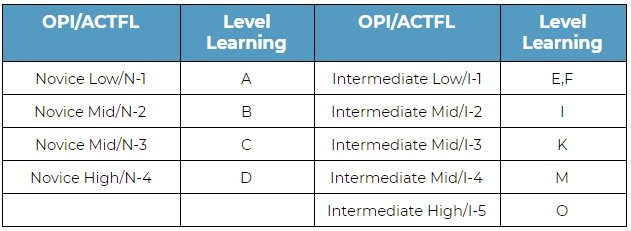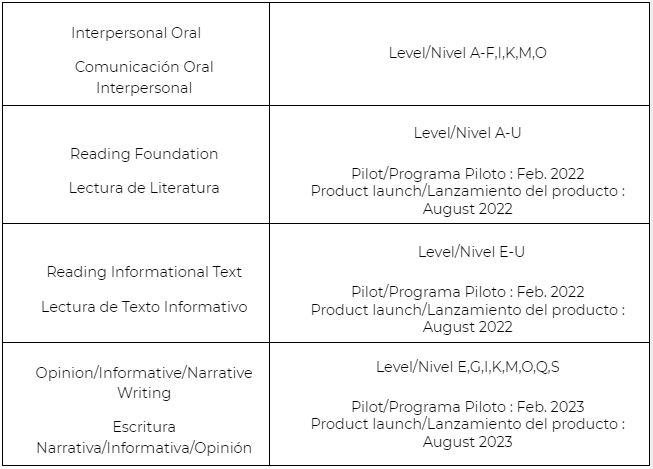Standards Mapping
-
Standards for Chinese
标准对照表 -
Standards for Spanish
Estándares en español
Based on well researched language frameworks, the Level Learning team developed a set of systematic and demonstrable interpersonal oral, reading and writing levels and standards.
在针对各类语言框架进行了充分的研究后,Level Learning团队自主研发了一套系统化的语言分级标准,内容覆盖
日常交际口语、阅读和写作。

- ACTFL
- Common Core
- Chinese National Curriculum 中国语文课程标准
ACTFL Proficiency Level Mapping to Level Learning
等级对照图
Chinese Reading 中文阅读

Chinese Writing 中文写作

Chinese Interpersonal Oral 中文日常交际口语

Level Learning’s levels and standards were developed based on the Common Core ELA Anchor Standards. The diagram below shows the relationship between Common Core Anchor Standards and Level Learning reading and writing standards.
Level Learning的级别和标准是基于Common Core ELA Anchor Standards而制定的。从下面的图表中可以看出Common Core Anchor Standards和Level Learning阅读及写作标准之间的关系。
Common Core for ELA
Language and Reading Anchor Standards
语言及阅读标准


Common Core for ELA
Writing Anchor Standards
写作标准

Oral Standards
口语标准

中国语文课程标准确定了识字、读、写和说的标准。这些标准通过教授相应年级的课本得以体现。我们详细地分析了中国语文课程标准,发现这些标准与美国共同核心标准阅读的框架有共通之处。由于Level Learning标准是基于美国共同核心标准框架,因此可以说Level Learning标准与中国语文课程标准有共通之处。请查看下面的概述。详细的对应分析文件可以在登录后查看。
Chinese National Curriculum (中国语文课程标准) identifies standards for character recognition, reading, writing and speaking. These standards are expected to be instructed along with the textbooks designated for each grade. We unpacked the reading standards and found that they correlate with the Common Core Reading Framework. Since Level Learning standards are designed based on Common Core Framework, Level Learning’s standards also correlate with Chinese National Curriculum (中国语文课程标准). Please see below for high level summary. Detailed mapping is available after login.

我们根据Level Learning的文本分级标准,以部编版语文课本作为参考,为一到九年级的大部分课文进行了分级。下面的表格展示了每册课本主要覆盖的等级分布。这些等级可以和各年级的目标等级相互参照,并且得到了北京某所知名双语学校的验证。这些年级的目标等级设置是根据Level Learning评估系统多年来累积的测试数据分析得出的。因为中国语文课程标准和Level Learning标准都是基于类似的框架,所以教师可以参考和结合Level Learning的相应等级来指导和准备语文课本的教学。同时,教师还可以从Level Learning的测试系统中获得数据,从而进一步指导学生的学习。
Using Level Learning Text Complexity Standards, we identified the level of most texts in the G1-9 textbooks using 部编版语文课本 as a reference. The table below shows the key range of text levels in each textbook. These levels were further cross-referenced with the grade level performance targets and validated by a leading bilingual school in Beijing, China. The grade level performance targets were set based on multiple years of collected student data using the Level Learning assessments. Given CNC and Level Learning standards are based on similar framework, teachers can plan instruction of a text in the textbook using standards in the matching level within Level Learning. In addition, teachers can obtain data on student learning based on assessment results in Level Learning system.

Based on well researched language frameworks, the Level Learning team developed a set of systematic and demonstrable interpersonal oral, reading and writing levels and standards.
Basado en marcos lingüísticos bien investigados, el equipo de Level Learning ha desarrollado un conjunto de niveles y estándares sistemáticos y demostrables para la lectura, escritura y comunicación oral interpersonal.

-
ACTFL
Mapping - Common Core Standards
- Florida B.E.S.T. Standards
- Texas Essential Knowledge and Skills
- Text Leveling
ACTFL Proficiency Level Mapping to Level Learning
Reading

Interpersonal Oral

Writing

Level Learning’s levels and standards were developed based on well researched frameworks. Our reading and writing standards are developed and further unpacked from the Common Core Spanish Language Arts Standards. And our oral standards are developed and further unpacked from the ACTFL interpersonal oral CAN-DO statements. The diagrams below show how our standards are organized.
Level Learning added on the following two key points to support teachers carry out systematic and explicit differentiated instruction in a time efficient manner:
- Instead of grade level, each one of our reading and writing standards is placed in context of a specific text complexity level. This text complexity level serves two purposes:
- Skills such as inferences have different meaning when paired with text of different complexity levels (e.g. inference in a picture book vs. inference in a chapter book). It is important to contextualize each standard with the appropriate level of text.
- We expect students to be able to work through multiple text complexity levels per school year. These levels allow teachers to monitor progress and differentiate their instruction all through the school year.
- Each standard/category in each text complexity level is further unpacked into a set of actionable and demonstratable learning objectives. Each learning objective is supported with :
- teaching resources such as assessments, analytics, mini-lessons, activities and
- independent practice resources such as books, quizzes, writing prompts, interactive oral games.
Language and Reading Standards
Estándares de lectura y lenguaje


Oral and Writing Standards
Estándares orales y de escritura


Level Learning’s standards address the same components and skills as the Florida B.E.S.T. standards. The diagrams (see below) of standard encoding of the Florida’s B.E.S.T standards and the Level Learning standards show the same components and skills are covered in the 4 language domains: listening, speaking, reading and writing. Details of the mapping can be found here.
Level Learning added on the following two key points to support teachers carry out systematic and explicit differentiated instruction in a time efficient manner:
- Instead of grade level, each one of our reading and writing standards is placed in context of a specific text complexity level. This text complexity level serves two purposes:
- Skills such as inferences have different meaning when paired with text of different complexity levels (e.g. inference in a picture book vs. inference in a chapter book). It is important to contextualize each standard with the appropriate level of text.
- We expect students to be able to work through multiple text complexity levels per school year. These levels allow teachers to monitor progress and differentiate their instruction all through the school year.
- Each standard/category in each text complexity level is further unpacked into a set of actionable and demonstratable learning objectives. Each learning objective is supported with :
- teaching resources such as assessments, analytics, mini-lessons, activities and
- independent practice resources such as books, quizzes, writing prompts, interactive oral games.
Florida B.E.S.T

Level Learning





Level Learning’s standards completely align with the TEKS Spanish language arts and reading standards across Kindergarten through Grade 8.
- Strand 1: Foundational Language Skills
- Strand 2: Comprehension
- Strand 3: Response
- Strand 4: Collaboration
- Strand 5: Multiple Genres
- Strand 6: Author’s Purpose and Craft
- Strand 7: Composition and Presentation
- Strand 8: Inquiry and Research
The Level Learning team has prepared a correlation guide to assist teachers in using the Level Learning platform to achieve the goals of the TEKS objectives.
Some important details in the correlation:
- Each TEKS strand consists of a number of vertically aligned skills across grade levels. Level Learning standards also have similar vertical alignment design but each standard is aligned across a number of levels represented by letters. Each level represents increasing level of text complexity.
- Each level is made up granular standards. Typically, one skill in a TEKS strand is mapped to more than one Level Learning standard and the one Level Learning standard spirals up through a number of levels.
- Level Learning standards consists of the following sections:
- Phonics curriculum : available in May, 2022
- Fluency (F) : available in July, 2022
- Language and Vocabulary standards (L) : already in pilot
- Reading standards for Literature (RL) : already in pilot
- Reading standards for Informational Text (RI) : available in March 2022
- Oral standards (O) : available in May, 2022
- Reading Strategy Development : available in July, 2022
- Writing (W) : available in Feb, 2023
Mapping between Vista Level Spanish and TEKS Strand 2
This correlation chart illustrates how Avanza levels correlate to the Lexile leveling systems.


